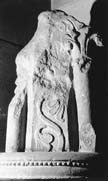Select a site alphabetically from the choices shown in the box below. Alternatively, browse sculptural examples using the Forward/Back buttons.
Chapters for this volume, along with copies of original in-text images, are available here.
Object type: Part of cross-shaft
Measurements: H. 51 cm (20 in); W. 31 > 28 cm (12.25 > 11 in); D. 16 cm (6.25 in) possibly tapering
Stone type: Stone: [Ancaster Freestone, Upper Lincolnshire Limestone, Inferior Oolite Group]
Plate numbers in printed volume: 470–1
Corpus volume reference: Vol 5 p. Vol 5 pp. 328–9
(There may be more views or larger images available for this item. Click on the thumbnail image to view.)
In interior south-west corner of tower, set on top of a large thirteenth-century capital
No direct evidence, but almost certainly from the site of the Cistercian abbey of Revesby, founded 1142, like other stone and ceramic material among which it is stored and displayed (Walter 1904, 167). There were excavations on the abbey site in 1869 (Barker 1869–70, 22–6).
Fair; slightly weathered, broken both top and bottom, and with surface damage to the upper part of the one visible broad face that carries over to the adjacent narrow face.
A fragment from the upper part of the tapered shaft of a cross. Its strong angle rolls are treated architecturally and topped by capitals with foliate volutes.
A (broad): Decorated in low relief with an acanthus trail, with leaves hanging down on alternate sides from an undulating stem. There are scooped tips on the leaves. The tips of three leaves that must have decorated the cross-head are visible off-centre.
B and D (narrow): Both have a run of dog-tooth filling the limited space between the angle rolls.
C (broad): Not clearly visible in present elevated location, but the surface is possibly broken away.
Appendix G item (the continuing tradition).
Both the capitals and the dog-tooth point to a date in the late twelfth century. The style of the leaves, too, is of a late Romanesque sort, showing an awareness of the mid-century work at Lincoln Cathedral, specifically on the principal west and north doors (Zarnecki 1988, 20–35). The interest of the piece lies in the analogy it provides in form and section to pieces such as St Guthlac's Stone at Crowland (no. 2, Ill. 456–7). Its architectural treatment of the angle rolls is reminiscent of the Digby shaft (Ills. 462–5) where it is the bases that survive; parallel treatment of angle shafts with volute capitals can be found at Aldborough, Yorkshire WR (Collingwood 1915, 134, fig. j). Its deployment of an undulating acanthus trail again provides a point of comparison with the Digby piece and also with the more elaborate shaft at Minting (Ills. 460–1). With shafts also in the churchyards at Binbrook and Bottesford, these examples show a continuing tradition of such monuments through the twelfth century from the latest pre-Conquest items such as the shaft at Harmston (Ills. 195–8).
A shaft with similar decoration, including nailhead and angle rolls treated architecturally and topped by capitals with foliate volutes, is illustrated in the Ross manuscripts as the base of a font at Moorby (LCL, Ross MSS vol. 8 (Horncastle, Bolingbroke and Skirbeck), facing 85). Though presumably of similar date, it is evidently square in section and larger than Revesby 1: the font bowl appears to be mid fourteenth-century or later.
Unpublished



